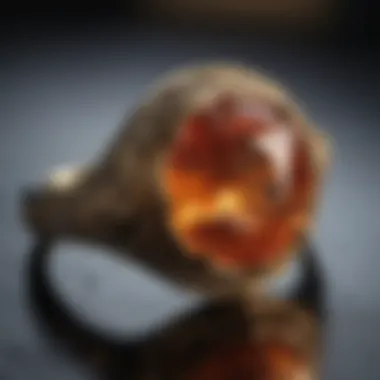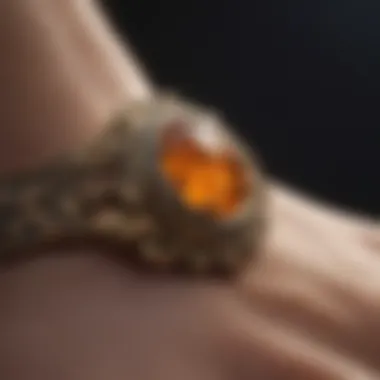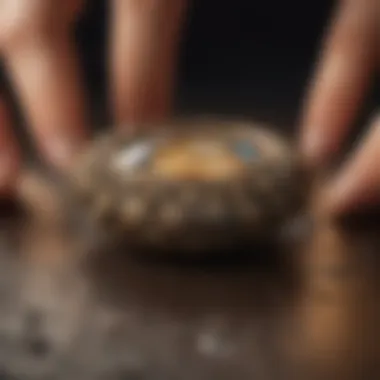Mastering the Art of Jewelry Making: Discovering the Finest Epoxy Glue


Epoxy glue is a crucial element in the intricate world of jewelry making, where precision and durability are paramount. Selecting the best epoxy glue for your jewelry projects requires careful consideration of key features and factors to ensure optimal results. Whether you're a novice jewelry artisan or a seasoned crafter, this comprehensive guide will equip you with the knowledge needed to create stunning jewelry pieces that stand the test of time.
Rock and Fossil Identification
The realm of jewelry making may not seem directly linked to the identification of rocks and fossils, but understanding the foundation of materials can greatly enhance your crafting skills. When exploring the world of epoxy glue for jewelry, knowing the characteristics of different rocks and fossils can aid in selecting the most suitable glue for your specific project. This section will delve into various types of rocks and fossils commonly used in jewelry making, the key characteristics to look for when identifying these materials, and the essential tools needed for accurate identification.
Collecting Tips and Techniques
While collecting rocks and fossils may differ from gathering jewelry-making materials, the principles of best practices remain the same. This section will provide valuable insights into the best techniques for collecting rocks and fossils, including tips on how to locate prime collecting sites and safely extract specimens for your projects. By understanding the intricate process of collecting geological materials, you can elevate your jewelry-making prowess and create truly unique pieces that incorporate nature's wonders.
Preservation and Display
Preserving the beauty of rocks and fossils is essential not only for scientific purposes but also for enhancing the aesthetics of your jewelry creations. This section will explore various techniques for preserving rocks and fossils, ranging from traditional methods to innovative approaches that maintain their natural allure. Additionally, you will learn about proper storage methods that keep your collection pristine and creative display ideas that showcase the beauty of these geological treasures in your jewelry pieces.
Geological Insights
To fully appreciate the significance of rocks and fossils in jewelry making, a broader understanding of geological formations and processes is necessary. This section will delve into the fascinating world of geological insights, exploring the formations and processes that shape our Earth's landscape. Furthermore, it will shed light on the historical significance of rocks and fossils, highlighting notable discoveries in the field that have contributed to our understanding of the planet's rich geological history.
Introduction
Crafting exquisite jewelry pieces requires meticulous attention to detail, where every element plays a crucial role in the final product's quality. One such essential element in jewelry making is epoxy glue, a versatile adhesive that offers unmatched bonding strength and durability. Epoxy glue serves as the backbone of intricate jewelry designs, securing gemstones, metal components, and embellishments with precision and reliability. Understanding the significance of epoxy glue in jewelry making is paramount for both novice artisans and experienced crafters seeking optimal results.
Understanding the Significance of Epoxy Glue in Jewelry Making
Epoxy glue stands out in the realm of jewelry making due to its remarkable advantages that elevate the quality and longevity of crafted pieces. Its exceptional bonding strength surpasses traditional adhesives, ensuring flawless and lasting connections between different materials. This feature is pivotal in creating jewelry that withstands daily wear and maintains its aesthetic appeal over time. The unique property of epoxy glue lies in its ability to bond diverse materials like gemstones, metals, and resin, providing a versatile solution for various jewelry-making techniques.
Advantages of Using Epoxy Glue
The advantages of using epoxy glue are multifaceted, with one standout aspect being its unparalleled bonding strength. This strength ensures that jewelry components stay securely in place, enhancing the overall durability of the piece. Additionally, epoxy glue offers a level of precision that is unmatched, allowing artisans to create intricate designs with confidence. The high bonding strength, paired with precision application, results in professional-looking jewelry that exudes quality and craftsmanship.
Key Considerations for Selecting the Best Epoxy Glue
Bonding Strength
Bonding strength is a critical aspect to consider as it dictates how well the epoxy glue adheres to different materials. A high bonding strength is essential for securing gemstones and metal components firmly in place, preventing any dislodging or breakage. Opting for epoxy glue with superior bonding strength guarantees long-lasting and secure jewelry pieces that maintain their integrity even with daily wear.
Drying Time
The drying time of epoxy glue is another crucial factor to consider, especially for jewelry makers looking to optimize their work process. Fast-drying epoxy adhesives streamline the jewelry-making process, allowing artisans to complete projects efficiently. However, it is essential to strike a balance between quick drying times and workability to ensure precise application and positioning of components.
Clarity and Transparency
Clarity and transparency are key considerations when selecting epoxy glue for jewelry projects that involve embedding elements like gemstones or layered designs. Clear epoxy resin offers unmatched clarity, making it ideal for creating jewelry pieces with a transparent or glass-like finish. The transparency of the epoxy glue enhances the visual appeal of the jewelry by showcasing the embedded elements clearly and vibrantly.


Water Resistance
Water resistance is crucial for jewelry pieces subjected to everyday wear and exposure to moisture. Epoxy glue with high water resistance ensures that the bonds remain intact and secure, even when the jewelry comes into contact with water. This feature helps maintain the structural integrity of the jewelry over time, preventing any deterioration due to moisture exposure.
Flexibility
Flexibility in epoxy glue is essential for jewelry pieces that may undergo slight movements or bending. A flexible adhesive allows the jewelry components to move naturally without compromising the bond, reducing the risk of breakage. Opting for epoxy glue with a degree of flexibility ensures that the jewelry adapts to the wearer's movements comfortably, enhancing both the durability and comfort of the crafted piece.
Types of Epoxy Glue Suitable for Jewelry
Various types of epoxy glue cater to different requirements in jewelry making, offering unique features and benefits that cater to specific crafting needs. Clear epoxy resin, colored epoxy resin, UV-activated epoxy, and high-temperature epoxy each provide distinct advantages for jewelry artisans seeking versatile and reliable adhesive solutions.
Clear Epoxy Resin
Clear epoxy resin is favored for its exceptional clarity and transparent finish, making it ideal for projects where visual appeal is paramount. This type of epoxy glue ensures that embedded elements like gemstones or miniature designs are showcased with stunning clarity, enhancing the overall aesthetic of the jewelry piece. Additionally, clear epoxy resin offers superior bonding strength and water resistance, making it a versatile choice for various jewelry-making applications.
Colored Epoxy Resin
Colored epoxy resin introduces a vibrant and customizable element to jewelry making, allowing artisans to incorporate a pop of color into their designs. This type of epoxy glue offers the same reliable bonding strength and durability as clear epoxy resin, with the added benefit of providing a range of color options to suit different design preferences. Whether used for highlighting details or creating striking contrasts, colored epoxy resin adds a creative dimension to jewelry pieces.
UV-Activated Epoxy
UV-activated epoxy offers a convenient and efficient bonding solution for jewelry makers looking for quick curing times and precise results. This type of epoxy glue cures rapidly under ultraviolet light, reducing the waiting time between application and bonding. UV-activated epoxy is ideal for intricate designs that require instant adhesion and minimal drying time, allowing artisans to expedite their jewelry-making process without compromising quality.
High-Temperature Epoxy
High-temperature epoxy is designed to withstand extreme heat conditions, making it suitable for jewelry projects that may be exposed to high temperatures during wear or manufacturing processes. This type of epoxy glue maintains its bonding strength and integrity even in elevated temperatures, ensuring that the jewelry remains structurally sound and secure. High-temperature epoxy is particularly beneficial for crafting jewelry pieces that require additional resilience against heat-related stress.
Factors Influencing Epoxy Glue Performance
In the intricate world of jewelry making, the performance of epoxy glue plays a crucial role in ensuring the longevity and quality of the final piece. Understanding the factors that influence epoxy glue performance is essential for selecting the right adhesive that complements the specific requirements of jewelry crafting. Factors like environmental conditions, surface preparation, and application techniques significantly impact the bond strength, clarity, and overall durability of the epoxy glue used in jewelry projects.
Environmental Conditions
Temperature
Temperature control is paramount in the successful application of epoxy glue in jewelry making. The ideal temperature ensures proper curing and bonding of the adhesive with the materials, promoting a strong and lasting connection. Variances in temperature can affect the drying time and the overall performance of the epoxy glue, making it imperative to work in a controlled environment to achieve the desired results.
Humidity
Similarly, humidity levels can influence the curing process and adhesion strength of epoxy glue. High humidity can slow down the drying time, leading to potential issues like air bubbles or incomplete bonding. Conversely, low humidity might accelerate the curing process excessively, affecting the clarity and final finish of the jewelry piece. Maintaining optimal humidity levels in the workspace is key to ensuring the epoxy glue sets correctly and delivers the desired outcomes.
Surface Preparation
Cleaning


Proper cleaning of the surfaces to be bonded is a critical step in preparing for epoxy glue application. Removing any dirt, dust, or oils from the materials ensures maximum adhesion and prevents potential separation over time. Thorough cleaning with suitable solvents or detergents prepares the surface for optimal bonding, enhancing the overall strength and longevity of the jewelry piece.
Sanding
Sanding the surfaces intended for bonding helps create a rough texture that promotes better adhesion of the epoxy glue. The roughened surface offers more contact points for the adhesive to grip onto, increasing the bond strength and durability of the joint. Careful sanding techniques ensure a uniform and proper surface for the epoxy glue application, facilitating a secure and long-lasting bond between the materials.
Application Techniques
Mixing Ratios
Accurate mixing ratios of epoxy resin and hardener are vital for the proper functionality of the adhesive. Deviating from the specified ratios can lead to issues like incomplete curing, weakened bond strength, or a tacky finish. Following the manufacturer's instructions regarding mixing proportions and ensuring thorough blending of the components are crucial for achieving optimal results in jewelry making projects.
Precision Application
Precision application of epoxy glue involves carefully dispensing and spreading the adhesive to achieve uniform coverage and proper alignment of the bonded components. Uneven application can result in excess glue seepage, air bubbles, or misalignment of the jewelry elements. Diligent application techniques, such as using syringes or precision tips, enable accurate placement of the adhesive, ensuring a seamless and professional finish for the jewelry piece.
Top Picks: Best Epoxy Glue Products for Jewelry
Product A: Premium Jewelry Epoxy
Features and Benefits:
Unveiling a premium jewelry epoxy that revolutionizes the way craftsmen adhere components. This epoxy boasts exceptional adhesion strength, ensuring that your jewelry will withstand the test of time. Its unique feature lies in its rapid curing time, allowing for efficient workflow without compromising quality. Crafted for professionals and hobbyists alike, the versatility and durability of this epoxy make it an indispensable tool in jewelry making. While it excels in bonding strength and clarity, ensuring a professional finish, its only downside lies in its slight viscosity, which may require precise application techniques.
Application Tips:
When using this premium jewelry epoxy, precision is key. Ensure surfaces are clean and free of debris before applying the adhesive to optimize its bonding strength. Utilize precise application techniques to avoid excess glue that may compromise the aesthetic of your jewelry piece. This epoxy sets quickly, so work swiftly and accurately to achieve optimal results without mistakes or rework.
Product B: Quick-Setting Epoxy Adhesive
Pros and Cons:
Introducing a quick-setting epoxy adhesive that offers a convenient solution for jewelry artisans looking to streamline their workflow. The key advantage of this adhesive lies in its fast curing time, allowing for efficient project completion. It provides a strong bond suitable for various jewelry components. However, its quick-setting nature can also be a drawback, as it requires swift and precise application to avoid mistakes or improper bonding.
Customer Reviews:
Customer reviews attest to the reliability and effectiveness of this quick-setting epoxy adhesive. Users appreciate its ease of use and quick drying time, making it ideal for both amateur and professional jewelry makers. However, some have noted that its speedy curing process leaves little room for error, necessitating careful planning and execution during application.
Product C: Crystal Clear Epoxy Resin
Usage Instructions:
Discover the crystal clear epoxy resin designed to elevate the transparency and aesthetic appeal of your jewelry pieces. With comprehensive usage instructions, this resin simplifies the application process, making it suitable for crafters of all skill levels. Its key characteristic lies in its ability to cure without leaving any residue or cloudiness, ensuring a flawless finish every time.


Curing Process:
The curing process of this crystal clear epoxy resin is a crucial step in achieving professional results. Its rapid curing time allows for quick project turnaround without compromising quality. The unique feature of this resin is its self-leveling properties, which eliminates the need for extensive polishing or touch-ups. However, its fast curing nature also requires precise timing and application to avoid any imperfections in the final jewelry piece.
Application Tips for Using Epoxy Glue in Jewelry Making
In the intricate realm of jewelry making, the application tips for using epoxy glue play a vital role in ensuring precise and durable creations. For jewelry artisans, understanding the nuances of applying epoxy glue is crucial for achieving impeccable results. These application tips encompass a range of techniques that can enhance the bonding strength, clarity, and resistance of the jewelry pieces. By focusing on the details of epoxy glue application, artisans can elevate their craft to achieve professional-grade jewelry pieces.
Precision Bonding Techniques
Securing Gemstones
Securing gemstones with epoxy glue is a fundamental aspect of jewelry making, as it ensures the longevity and security of the precious stones in the design. The key characteristic of securing gemstones lies in the ability of epoxy glue to create a strong and reliable bond that can withstand everyday wear. Artisans often prefer this method for its ease of application and its ability to securely hold gemstones of various shapes and sizes. The unique feature of securing gemstones with epoxy glue is its versatility, allowing artisans to create intricate designs without compromising on the durability of the final piece.
Attaching Metal Components
When it comes to attaching metal components in jewelry making, using epoxy glue offers a seamless and durable solution. The key characteristic of attaching metal components with epoxy glue is the ability to create a strong and lasting bond that can withstand constant movement and handling. Artisans favor this method for its precision and reliability in bonding metal pieces together. The unique feature of attaching metal components with epoxy glue is its versatility in adhering to different types of metals, providing a secure foundation for intricate jewelry designs.
Avoiding Common Pitfalls
Air Bubbles
Air bubbles are a common challenge faced when working with epoxy glue in jewelry making. These bubbles can detract from the clarity and aesthetic appeal of the finished piece, highlighting the importance of proper application techniques. Artisans must carefully mix the epoxy resin to minimize the formation of air bubbles and ensure a smooth and flawless finish. While air bubbles can be an unwanted occurrence, with attention to detail and precision in application, artisans can effectively avoid this common pitfall.
Excess Glue
Excess glue can lead to messy and unprofessional-looking jewelry pieces, making it essential to understand how to manage the amount of epoxy glue during application. The key characteristic of avoiding excess glue lies in practicing precision and restraint when dispensing the adhesive onto the jewelry components. By following recommended mixing ratios and applying the epoxy glue with care, artisans can prevent the accumulation of excess glue and achieve clean and polished jewelry pieces.
Finishing Touches
Polishing
Polishing jewelry pieces after applying epoxy glue is a crucial step in enhancing the overall aesthetics and shine of the finished creation. The key characteristic of polishing lies in its ability to smoothen the surfaces of the jewelry components, removing any imperfections and achieving a professional finish. Artisans often use polishing techniques to elevate the visual appeal of their jewelry pieces and create a lustrous and captivating final product. The unique feature of polishing is its transformative effect, turning rough surfaces into glossy and refined elements in the jewelry design.
Sealing
Sealing jewelry pieces with epoxy glue offers protection and durability, ensuring that the components remain securely bonded over time. The key characteristic of sealing lies in its ability to create a barrier that shields the jewelry from external factors such as moisture and impact. Artisans value this step for its ability to prolong the lifespan of their creations and maintain the integrity of the design. The unique feature of sealing with epoxy glue is its seamless application, providing a secure and long-lasting finish to the jewelry pieces.
Conclusion
In the realm of jewelry making, selecting the best epoxy glue is a crucial step towards achieving optimal results in crafting intricate pieces. The Conclusion section of this guide plays a pivotal role in summarizing the significance of epoxy glue in jewelry projects. By understanding the benefits and considerations highlighted throughout this article, jewelry artisans, both novice and experienced, can elevate their skills and create stunning pieces with precision and durability. The Conclusion segment serves as a comprehensive resource that encapsulates the key points discussed, enabling craftsmen to make informed decisions when choosing epoxy glue for their jewelry creations.
Elevate Your Jewelry Crafting with the Right Epoxy Glue
Enhanced Durability
Enhanced Durability is a cornerstone aspect that significantly contributes to the overall quality and longevity of jewelry pieces created with epoxy glue. The key characteristic of Enhanced Durability lies in its capacity to provide exceptional strength and resilience, ensuring that the bonds formed by the glue withstand the test of time. This characteristic makes Enhanced Durability a popular choice among jewelry makers seeking long-lasting and robust adhesion for their creations. Furthermore, the unique feature of Enhanced Durability lies in its ability to resist external factors such as moisture, temperature variations, and everyday wear, enhancing the reliability of jewelry pieces. Despite its numerous advantages, craftsmen should be mindful of the curing time required for epoxy glue with Enhanced Durability, as it may extend the overall crafting process but ultimately ensures a high-quality final product.
Professional Finish
A Professional Finish is a defining element that adds finesse and sophistication to jewelry pieces crafted with the right epoxy glue. The key characteristic of Professional Finish is its capability to provide a flawless and polished look to jewelry components, enhancing their aesthetic appeal. Jewelry artisans opt for epoxy glue with a Professional Finish due to its ability to create seamless bonds that blend seamlessly with the materials used in the piece, giving it a refined appearance. The unique feature of Professional Finish lies in its versatility, allowing craftsmen to achieve various textures and finishes, from matte to glossy, suiting diverse design requirements. While offering a myriad of advantages in terms of appearance, Professional Finish may require meticulous application techniques to avoid excess glue and ensure pristine results, a factor that artisans should prioritize when utilizing this type of epoxy glue in their jewelry projects.







